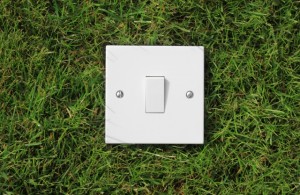Energy Efficiency
Save some green and lower your carbon footprint by reducing your energy consumption around the house.
Save some green and lower your carbon footprint by reducing your energy consumption around the house.
In an age where technological devices play a pivotal part in the day to day functions of life, it can be difficult to consider just how much energy is being used in homes across the country. Smartphones, TV’s, laptops, washing machines, refrigerators etc.; the list is endless. Of course many of these items are essential to ensure we maintain a decent standing of living, but what can be done to ensure people are taking responsibility of their carbon footprint. Here we look at some simple tips which will not only reduce energy usage, but can also save the consumer money.
 Although that small red light at the bottom of your TV screen or DVD player, when in standby mode, may look insignificant, however that red light could be costing a home over $60 a year to maintain. Does it make sense to pay $60 for something which is not being used? Simply once you have finished watching your TV switch it off. If this still is an issue consider investing in adjustable time plug adapters which can be set to turn off a product at specified times. This also applies to both laptops and mobile phones. Although modern smart phones need regular charges to maintain battery life, to charge one to its optimum usually takes no longer than an hour, but people still persist on charging them throughout the night. Again, not only is this a waste of electricity but in the long term can damaged the phone if overcharged.
Although that small red light at the bottom of your TV screen or DVD player, when in standby mode, may look insignificant, however that red light could be costing a home over $60 a year to maintain. Does it make sense to pay $60 for something which is not being used? Simply once you have finished watching your TV switch it off. If this still is an issue consider investing in adjustable time plug adapters which can be set to turn off a product at specified times. This also applies to both laptops and mobile phones. Although modern smart phones need regular charges to maintain battery life, to charge one to its optimum usually takes no longer than an hour, but people still persist on charging them throughout the night. Again, not only is this a waste of electricity but in the long term can damaged the phone if overcharged.
Maintaining the heat of a home is of course essential to ensuring adequate living standards, but that is one area of energy consumption which can prove to be most costly. It’s estimated that a home can lose 30% of the energy used simply through poor insulation. External solid wall insulation is being introduced through the government green deal scheme to ensure homes and offices are not wasting money and energy. The exterior insulation acts as a thermal resistant barrier around the property to ensure less energy can escape. This rule can apply throughout the whole property especially in areas such as loft cavities. As heat rises it’s inevitable that heat will escape through the loft and cavity spaces. By ensuring the specified levels of insulation is in the property, you will continue to save money and energy for years to come.
This has been a question many homeowners have asked for years, what uses more water, a bath or shower? Quite simply, it depends on the individual in question. A shower which takes a few minutes will inevitably use less water compared to a bath, but a long shower may use around the same amount of water. Solution? Take less baths and have more showers, this way your water usage should decrease along with the amount of money actually spent on bills.
There are many ways in which people can begin to reduce the amount of energy they use within the home and by starting with these small suggestions it will hopefully lead to larger steps in the future.
—
Author Bio: Paul Stephenson is a green deal advisor working with businesses and homeowners on how to reduce energy consumption.